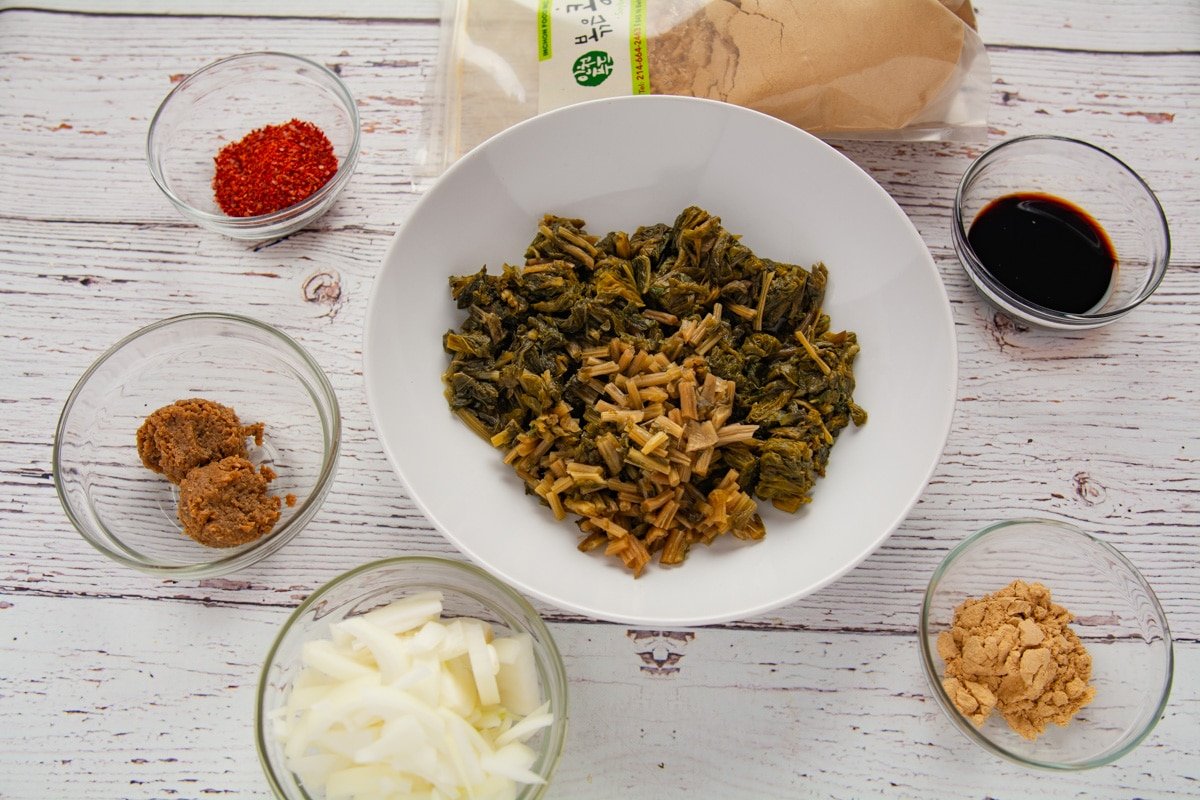Most recipes for soybean paste stew or doenjang-jjigae will use some vegetables. This version uses dried radish greens as the main vegetable. Radish is a common vegetable in Korean cooking. Traditionally when harvesting radish, the steams and leaves would be removed and hung up to dry.
Then throughout the long winter months, the stems and leaves (Siraegi) would find their way into soups (guk), side dishes, or cooked with rice. Let’s get started cooking our Siraegij-doenjang-jjigae.
Radishes are low in purines, and the stems and leaves are loaded with fiber, so they are a great choice for gout sufferers. Normally the stems and leaves would be in a soup, but I prefer stew, which I made.
It is common for doenjang-jjigae to have some seafood and even shellfish but to keep this recipe gout friendly, we will make a vegan version. Doenjang-jjigae is known as a ‘Rice Thief,’ a well-known Korean saying for dishes that are so delicious that the accompanying rice is gone quickly.

This is a 100 gram package that we bought at a Korean market. For the stew we will only use half of the package but we will prepare all of package.

This is what the stems and leaves look like out of the package. The things that look like dried flowers are where the stems were cut from the radish.

To prepare the stems place them in a big pot of cold water with half a Tablespoon of salt and half a teaspoon of baking soda. The baking soda will help the stems get tender. Some people use sugar instead of baking soda.
If you use baking soda, do not blanch them too long, or the leaves will start breaking down.
To blanch them, place them into a pot of cold water with salt and baking soda (or sugar) and cover and bring to a boil. While they are boiling, you do want to stir them around in the pot occasionally, or the ones on top do not cook as fast. Boil for ten minutes, then rinse them off in cold water.

After blanching, you will need to remove the outside layer from the stems. Cut off the part that attaches to the radish and scrape the outside of the stem and peel off the almost plastic layer.

This is what the stems looked like after removing the outside layer. After removing the “plastic” layer, you can chop them up. My wife said that I cut them up to small. After cutting them up, I was informed that the pieces should have been about double the length.

Time to season the leaves. This is half of the stems that we balanced.
We used Korean red pepper flakes, soybean paste (without seafood), onions, soy sauce, and ground soybeans (optional). All of these ingredients were added to the leaves and mixed up.
Ground soybeans are optional. If you do not have them, then do not worry. A ubiquitous seasoning ingredient is ground perilla seeds, but we did not have any.
We seasoned the extra leaves the same way, put them in a bag, and went in the freezer. They are ready for the next time we want stew.

All of our ingredients
We also need some green onion, green peppers, and rice water. For the green pepper, we use Korean peppers, but jalapenos also work.
Rice water is simple water we saved while washing rice. Water from the first rise is discarded, and the second and third rise has lots of starch. Using this water will help to make the stew thicker. Rice water is also good for watering plants.
To cook, add the seasoned stems to a pot, add the rice water and bring to a boil. And cook for ten minutes and taste for seasoning. If needed, add salt.
After adjusting seasoning add the green onion and green peppers and cook for two more minutes. The dish is now ready to serve.

Please share this recipe with your friends.

Ingredients
Blanch the leaves
- 50 grams Dried radish leaves
- 1/2 Tablespoon Sea salt
- 1/2 teaspoon Baking soda
- 6 Cups Water
Season the leaves
- 1 Tablespoon Korean red pepper flakes
- 2 Tablespoons Soybean paste
- 1 Tablespoon soy sauce
- 1 Tablespoon Ground soybeans
- 1/2 Onion medium
For the stew
- 1.5 Cups Rice water
- 2 Green onions chopped
- 1 Green pepper Spicy, chopped
Instructions
Prepare the stems and leaves
- To blanch them, place them into a pot of cold water with salt and baking soda (or sugar) and cover and bring to a boil. While they are boiling, you do want to stir them around in the pot occasionally, or the ones on top do not cook as fast. Boil for ten minutes, then rinse them off in cold water.
- After blanching cut off the part that attaches to the radish and scrape the outside of the stem and peel off the almost outside layer.
- Chop up the stems and leaves.
- Add Korean red pepper flakes, soybean paste, onions, soy sauce, and ground soybeans. Give a good mix and set aside.
- Chop up the green onion and spicy pepper.
Cook
- Add the seasoned stems to a pot, add the rice water and bring to a boil. And cook for ten minutes and taste for seasoning. If needed, add salt.
- After adjusting seasoning add the green onion and green peppers and cook for two more minutes. The dish is now ready to serve.